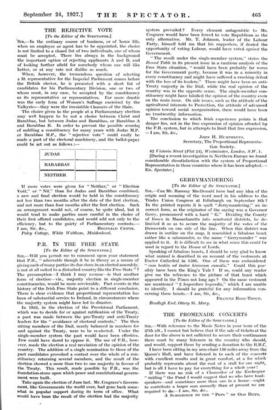THE REJECTIVE VOTE
[To the Editor of the SPECTATOR.] 'Sra,—In the ordinary course of business, or of home life, when an employee or agent has to be appointed, the choice is not limited to a closed list of two individuals, one of whom must be accepted. There lies always in the background the important option of rejecting applicants A and B, and of looking further afield for somebody whom one will like better, or at any rate not dislike so much.
When, however, the tremendous question of selecting a fit representative for the Imperial Parliament comes before the British elector, he is presented with a short list of candidates for his Parliamentary Division, one or two of whom must, in any case, be accepted by the constituency as its representative or representatives. Far more drastic was the early form of Women's Suffrage exercised by the Valkyries—they were the irresistible Choosers of the Slain.
The choice given to the people at a Parliamentary election may well happen to be not a choice between Christ and Barabbas, but between Judas and Barabbas, or Barabbas A and Barabbas B. In order to prevent the possible scandal of saddling a constituency for many years with Judas M.P. or Barabbas M.P., the " rejective vote " could easily be made a part of the electoral machinery, and the ballot-paper could be set out as follows
JUDAS BARABI1AS NEITHER If more votes were given for " Neither," or " Election Void," or " Nil," than for Judas and Barabbas combined, a new and final election would be held in the constituency not less than two months after the date of the first election, and not more than four months after the first election. Such an arrangement would not, of course, be quite ideal, but it would tend to make parties more careful in the choice of their first offered candidates, and would add not only to the efficiency, but to the gaiety of Parliamentary contests.—










































 Previous page
Previous page